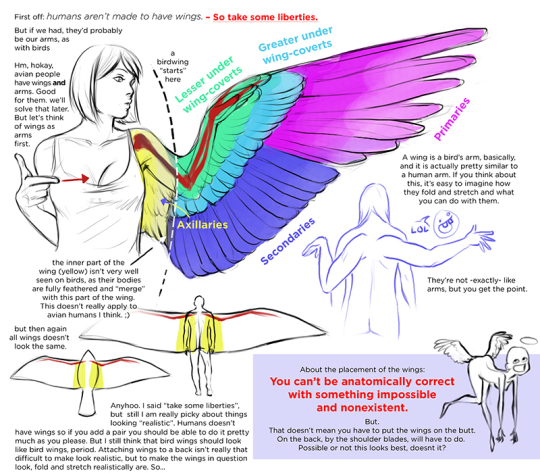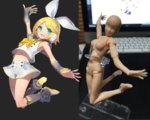That Zephyr Guy
crouton.net
Over the past few months, I've been seeing a lot of people fall into a very weird cycle:
They get into drawing (for the first time or again)
They draw something
They ask for critique on it
And then they get frustrated, leading to them either not drawing for a while or again period.

I'm hoping to make this thread as a means to give people a good idea of what they can do to improve as someone who is starting to draw, or are fairly inexperienced at drawing. (I'm not too good myself so I can't really offer solid advice for people who have been drawing longer than I have, y'know?)
First and foremost: the best tip I can give anybody on how to improve is to practice. It's really frustrating to watch somebody get super enthusiastic about art, and then give up when they aren't seeing results in a week. Drawing takes time. Drawing takes years. If you aren't willing to put in the effort to practice then you won't see results.
Next, what sort of medium are you planning on working on? Traditional, or digital?
If you want to learn traditional - pick up a sketchbook and a set of pencils, and practice.
If you want to learn digital - pick up a copy of either SAI or PS, as well as a tablet, and practice.
(If you need a copy of paint tool SAI, here is a link to version 1.1, the 2nd most recent version as of 4/10/16.)
But how do you practice? Surely there are better ways to rather than just drawing a bunch of really bad stuff, right? And yeah, that's true. There are more productive ways to learn, and I'll list out a couple of the ways that I practice:
Tracing. Tracing, I feel, gets a really bad rap in the art community. Whenever we hear the word "trace" all of our minds immediately jump to art theft. Tracing doesn't have to be bad, it just depends on how you use it. When I was learning how to draw as a 4th grader many years ago, the first thing I did was print out a bunch of pictures from my favorite anime and trace over them for hours and hours. Tracing as a learning tool is fantastic for teaching new artists the basics of anatomy, style, poses, flow, and even perspective. As long as you don't claim the art as your own, then there's nothing wrong with tracing.
After a certain point however, tracing won't be as effective. This is because you'll already be forming a style and will have the artistic skill to learn from pictures without having to trace. This is about where references become a good replacement, because while you're good enough to not have to rely on tracing, you still need to learn from other ways, so what ways are there?
Personally I study pictures that interest me, watch tutorials, keep a list of reference material, and mimick styles I'd like to see in my own art. There are other methods, but these are the ones I use.
Studying pictures that interest you. You ever see a picture that really just catches your eye and you don't know why? Save it, and look at it when you draw. Chances are something in the picture really caught your attention and you can use it to apply new techniques to your own art. For example, if I'm scrolling through tumblr or reddit and somebody posts a picture of a person doing a backflip, I might keep the picture in my bookmarks for a while so I can look at it every once in a while to get a better understanding of how people's bodies work while they're in that particular motion.





Watch tutorials. I think this is honestly the 2nd best tip I can somebody apart from simply practicing. There's a reason that people teach art classes, and there's a reason why tutorials are so popular on youtube. They give you a detailed step-by-step guide on how to draw better. Very recently in fact, I had been having problems learning perspective, and on a quick google search I found this very helpful video:
Keep a list of reference materials. Nobody can be expected to know how to draw everything perfectly. Learning how to draw something comes from hours or days of practice to learn it's nuances. Keeping your references handy is very good for when you find yourself stuck on a particular part of a picture.




Mimick styles you want to see in your own art. The biggest complaint I hear from artists is "I can't seem to develop a style". Everybody has a style, it's just all about developing a style that you like. Biggest thing you can do to forge your own style is see the things in styles you like and implement them into your own work. Sooner or later, bits and pieces of the things you like will find their way into your work and your style will probably feel a lot more comfortable to you. Keep in mind though, as an artist, you're bound to be overcritical of your work. Nobody will hate your work more than you do.
Never stagnate. Something I'm sometimes guilty of, and I see so many people guilty of too, is that they never leave their comfort zone. They're afraid to feel bad. They're afraid of failure. Don't be. Failing is the first step to improvement. Pain is just weakness leaving the body. That sort of deal. I have a little mantra that I say to myself occasionally when I learn something new, "Difficulty breeds excellence.". In short, nothing worth having is easy. If you're having a difficult time, you're likely on the right path.
Another thing that can help you learn to draw, and this is very particular with perspective and anatomy, is to look up pose generators. Setting aside an hour or even just 30 minutes a day to draw randomly generated poses will benefit you significantly.
They get into drawing (for the first time or again)
They draw something
They ask for critique on it
And then they get frustrated, leading to them either not drawing for a while or again period.

I'm hoping to make this thread as a means to give people a good idea of what they can do to improve as someone who is starting to draw, or are fairly inexperienced at drawing. (I'm not too good myself so I can't really offer solid advice for people who have been drawing longer than I have, y'know?)
First and foremost: the best tip I can give anybody on how to improve is to practice. It's really frustrating to watch somebody get super enthusiastic about art, and then give up when they aren't seeing results in a week. Drawing takes time. Drawing takes years. If you aren't willing to put in the effort to practice then you won't see results.
Chuck Jones said:Every artist has thousands of bad drawings in them and the only way to get rid of them is to draw them out.
Next, what sort of medium are you planning on working on? Traditional, or digital?
If you want to learn traditional - pick up a sketchbook and a set of pencils, and practice.
If you want to learn digital - pick up a copy of either SAI or PS, as well as a tablet, and practice.
(If you need a copy of paint tool SAI, here is a link to version 1.1, the 2nd most recent version as of 4/10/16.)
But how do you practice? Surely there are better ways to rather than just drawing a bunch of really bad stuff, right? And yeah, that's true. There are more productive ways to learn, and I'll list out a couple of the ways that I practice:
Tracing. Tracing, I feel, gets a really bad rap in the art community. Whenever we hear the word "trace" all of our minds immediately jump to art theft. Tracing doesn't have to be bad, it just depends on how you use it. When I was learning how to draw as a 4th grader many years ago, the first thing I did was print out a bunch of pictures from my favorite anime and trace over them for hours and hours. Tracing as a learning tool is fantastic for teaching new artists the basics of anatomy, style, poses, flow, and even perspective. As long as you don't claim the art as your own, then there's nothing wrong with tracing.
After a certain point however, tracing won't be as effective. This is because you'll already be forming a style and will have the artistic skill to learn from pictures without having to trace. This is about where references become a good replacement, because while you're good enough to not have to rely on tracing, you still need to learn from other ways, so what ways are there?
Personally I study pictures that interest me, watch tutorials, keep a list of reference material, and mimick styles I'd like to see in my own art. There are other methods, but these are the ones I use.
Studying pictures that interest you. You ever see a picture that really just catches your eye and you don't know why? Save it, and look at it when you draw. Chances are something in the picture really caught your attention and you can use it to apply new techniques to your own art. For example, if I'm scrolling through tumblr or reddit and somebody posts a picture of a person doing a backflip, I might keep the picture in my bookmarks for a while so I can look at it every once in a while to get a better understanding of how people's bodies work while they're in that particular motion.





Watch tutorials. I think this is honestly the 2nd best tip I can somebody apart from simply practicing. There's a reason that people teach art classes, and there's a reason why tutorials are so popular on youtube. They give you a detailed step-by-step guide on how to draw better. Very recently in fact, I had been having problems learning perspective, and on a quick google search I found this very helpful video:
Keep a list of reference materials. Nobody can be expected to know how to draw everything perfectly. Learning how to draw something comes from hours or days of practice to learn it's nuances. Keeping your references handy is very good for when you find yourself stuck on a particular part of a picture.




Mimick styles you want to see in your own art. The biggest complaint I hear from artists is "I can't seem to develop a style". Everybody has a style, it's just all about developing a style that you like. Biggest thing you can do to forge your own style is see the things in styles you like and implement them into your own work. Sooner or later, bits and pieces of the things you like will find their way into your work and your style will probably feel a lot more comfortable to you. Keep in mind though, as an artist, you're bound to be overcritical of your work. Nobody will hate your work more than you do.
Never stagnate. Something I'm sometimes guilty of, and I see so many people guilty of too, is that they never leave their comfort zone. They're afraid to feel bad. They're afraid of failure. Don't be. Failing is the first step to improvement. Pain is just weakness leaving the body. That sort of deal. I have a little mantra that I say to myself occasionally when I learn something new, "Difficulty breeds excellence.". In short, nothing worth having is easy. If you're having a difficult time, you're likely on the right path.
Another thing that can help you learn to draw, and this is very particular with perspective and anatomy, is to look up pose generators. Setting aside an hour or even just 30 minutes a day to draw randomly generated poses will benefit you significantly.
Hopefully this FAQ will provide more accessibility to people looking to draw as well a people looking to improve at drawing, but moreso it hopefully cuts down on the people posting threads asking people to critique their 2nd piece of art ever.
I heavily encourage people to reply to this post with their methods of improvement. As much as we like to make fun of ourselves on here, we do in fact have an art community here on TBT, so the least we could do is help everyone out a little bit in terms of improvement.
Last edited:



